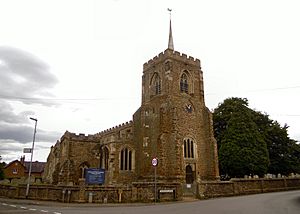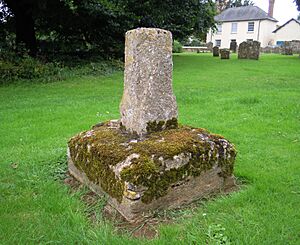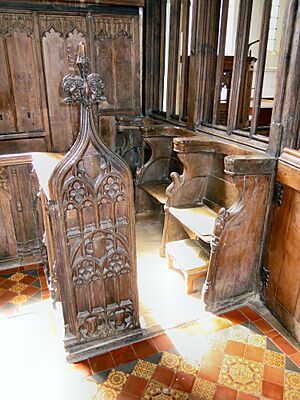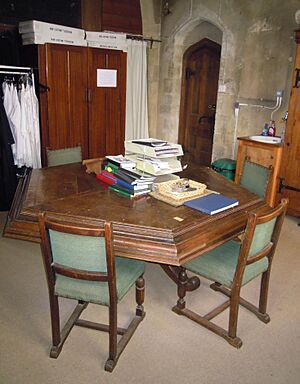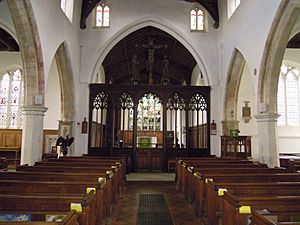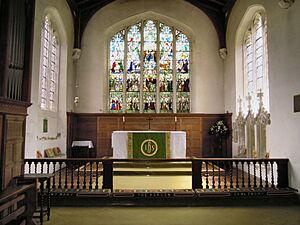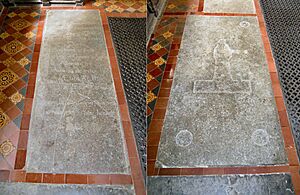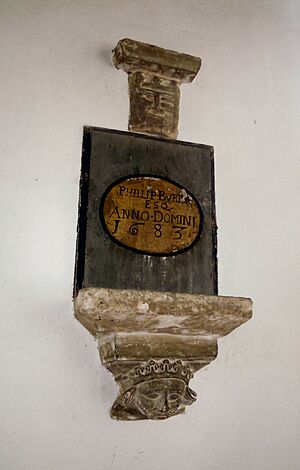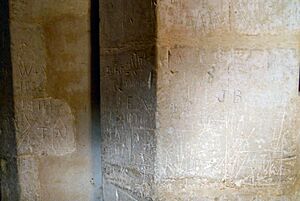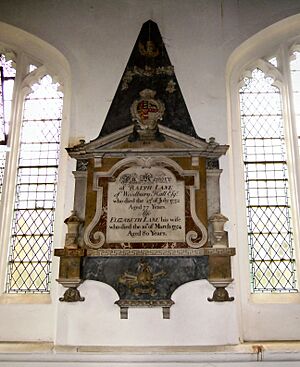Church of St Mary the Virgin, Gamlingay facts for kids
The Church of St Mary the Virgin is a very old and important church in the village of Gamlingay, Cambridgeshire. It is named after St Mary. This church is part of a larger church area that includes Gamlingay, Hatley St George, and East Hatley. Most of the church was built in the 1200s, but it was greatly changed and rebuilt in the 1300s and 1400s. Since 1967, it has been a Grade I listed building, which means it's a very special historic building. A famous expert named Nikolaus Pevsner said in 1954 that it was "the most impressive church in this part of the county."
Contents
Church Design and History
There was a church here even before the year 1120. However, the parts you see today are from the 1200s or later. This includes the main areas inside, like the South and North nave arcades, the North aisle, and the chancel. St Mary's church is built in a style called Early English Gothic. It has a square tower made from local stones. This tower now holds eight bells.
The South aisle and a small South chapel were added around 1300. The North porch was also built in the 1300s. Many parts of the church were changed in the 1400s and 1500s, but the main nave arches stayed the same.
The West Tower
The tall West tower was first built in the 1200s. It was largely rebuilt in the 1300s and 1400s. The tower has two main sections. At the top of the bell area, there's a decorative wall with battlements. You can see gargoyles above each tower window. Inside the church, a doorway leads to a spiral staircase. This staircase goes up to the bell chamber. On the east side of the tower, you can still see where an older, steeper roof used to be. The pointed spire on top is new, but the cross tree is original.
Vestry and Chancel
The current vestry (a room used by priests) was built during a big repair project in the 1880s. The unusual shape of the vestry table suggests it might have been part of an older pulpit.
The chancel (the area around the altar) looks like it's from the 1200s. Many details in the chancel are from 1442–43. At that time, Merton College, Oxford, helped pay for repairs. The South transept chapel was updated between 1460 and 1490 by local guilds. The North transeptal chapel was updated by Walter Taylard, who worked for Merton College. These changes might have finished around 1490.
Later Repairs and Features
Major repairs happened in the 1800s, especially in 1880. During this time, the vestry and South porch were rebuilt. The church has a reredos (a screen behind the altar) and other items given by William Meadston in 1683. The chancel has some funny-looking gargoyles. There are two on the North side and two at the East end. A smaller fifth gargoyle supports a cross on the gable.
The arch leading into the nave from the chancel is from the 1300s. The nave has a North arcade with five arches. These arches stand on eight-sided pillars. The nave also has a small opening called a squint that lets you see into the chancel.
The North aisle has four sections. The East section leads into the North chapel. The West wall was partly rebuilt in the 1400s. This aisle has four windows, three of which are from the late medieval period. At the East end, there's part of a 1200s tomb recess. The North chapel has two windows from the 1400s. The South porch was rebuilt in 1880. It has a decorative top and modern side windows. The roofs of the nave, aisles, and chapels are from the late medieval period. The chancel roof is new, but it rests on eight corbels (stone supports) from the 1400s. These are carved like half-angels holding shields.
Outside the Church
Outside the church, near the West door, there's a stoup from the late medieval period. This was used for holy water. A sundial is carved into a stone block on the South wall of the chancel. In the churchyard, south of the church, you can see parts of a medieval cross. This cross was used for preaching sermons. It was destroyed in 1643 by William Dowsing because it was considered idolatrous. The church also has several stone coffin lids. Some are built into benches in the North porch.
Church Fittings and Furnishings
The rood screen is a decorative screen that separates the nave from the chancel. It is mostly from the late medieval period. It has five sections, with the middle one being the entrance. It has been changed a lot over time. The oldest parts might have been put in place after repairs in the 1480s. You can still see traces of the old medieval paint colors: red, green, cream, and gold. Back then, there would have been a small winding staircase leading to the top of the screen. The doorway to this staircase is still there, but the stairs were blocked up during the Reformation. You can still see the first few steps next to the modern pulpit.
Seating and Sanctuary
In the North chapel, there are three updated pews (church benches). In the South chapel, there are two groups of four pews. These are similar to the ones in the North chapel. Most of these seats are from the late medieval period.
The sedilia (seats for the clergy) in the chancel are thought to be from the 1800s, but their side posts are from the 1400s. The stalls or pews inside the east side of the rood screen (three on each side) have carved designs. It's believed these seats were brought from another place. They were moved to their current spot during the 1880 restoration. They might have been for the six priests who lived in the village in 1490. The carvings on the seats show various figures, including an angel, animals, and a bishop. The two seats near the entrance have special carvings called misericords. On the north side, there's a crouching man and a demon's head. On the south side, there's an ape and grapes. Most of these carvings are from around 1442.
Bells and Other Features
The church has six bells. Three of them were made by Miles Graye in 1653. The others are either new or have been recast. The bell frame likely dates to around 1490. At that time, Bishop John Alcock blessed two new bells.
The church has several brass indents. These are outlines left in stone slabs where brass plates used to be. One in the chancel shows a priest. Others in the nave and South aisle show men and women. All of these are from the 1400s or 1500s.
In the southwest corner of the nave, there's part of a 1200s stone slab with an old inscription. The communion rails were added because William Meadston asked for them in his will (he died in 1683). The door in the tower is from the late medieval period. It used to be the main West doorway. Before the 1880 restoration, there were two baptismal fonts in the church. The current 1200s font has an eight-sided bowl. Its base has a central pillar and smaller pillars from the 1800s. The very bottom of the font might include parts of an even older font. The restored font cover is probably from the 1500s.
The stained glass at the top of the east window in the South chapel has pieces from the 1400s to 1600s. These include two small shields with the coat of arms of Fitzjames. A medieval locker in the South aisle was likely used to store banner poles for church processions. This shows that there were active groups and charities in the community.
Monuments and Memorials
Inside the chancel, on the south wall, there's a wall monument for Ann Say from 1793. It has an oval marble panel with an inscription. In the North aisle, there's a damaged tomb recess with part of a 1200s coffin lid. In the South aisle, on the south wall, you can see a colorful wall monument for Ralph Lane (died 1732) and his wife Elizabeth (died 1754). Nearby is another monument for their daughter Elizabeth Lane (died 1717). In the South chapel, on the east wall, there's a small painted wooden panel for Phillip Burton (died 1683).
The church also has several ledger stones. These are flat stone slabs on the floor that mark graves. One in the chancel is for Dixie Windsor (died 1743). Others are for Thomas Sclater (died 1696), Edward Sclater (died 1688), William Meadston (died 1683), and several others from the late 1600s and early 1700s. The arches in the nave still show traces of medieval red paint.
Old Graffiti
The church has many old carvings, or "graffiti," from different time periods. On one of the pillars in the North arcade, someone scratched in the 1400s, "hic est sedes Margarete Tayl . . d" (which means "this is the seat of Margaret Taylard"). This might have been done by Margaret, the wife of Walter Taylard, who helped rebuild the nearby North chapel.
On another pillar in the North arcade, there's a drawing from the medieval period. It looks like three small houses, perhaps on a street. On a pillar in the South arcade, someone scratched in the late medieval period, "mors cõparat / umbre que / semper / sequitur / corpus" (which means "death compares to the shadow that always follows the body"). On the North side of the West window in the tower, someone wrote in the 1500s, "Th[om]as [?Jek]yll Clar[ke] of Ga[m]ly[n]gaye" (Thomas Jekyll, Clerk of Gamlingay).


